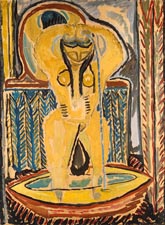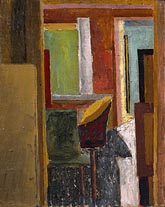|
Early influnces |
A European artist |
Modernism, Fry and post-impressionism |
Success in later years
Modernism, Roger Fry and post-impressionism

Surprisingly, during his time studying in Paris Grant did not come into direct contact with the Post-Impressionist work that would later have such a strong influence on his
painting style.
It was in 1909 while visiting Paris again that Grant saw Leo and Gertrude Stein's collection which included a number of works by Picasso.
He also visited Matisse, and was to meet up with both artists at regular intervals throughout the 1920s and 1930s.
Manet and the Post-Impressionists, an exhibition organised by Roger Fry in 1910, brought recent French art to London including work by CÚzanne, Gauguin, Van Gogh, Seurat,
Matisse and Derain.
Grant experimented with the new approaches he saw these artists using, and from about 1911 his work was transformed.
In 1912, Grant's painting The Queen of Sheba and work by other Bloomsbury artists appeared alongside paintings by European Post-Impressionists at the
Second Post-Impressionist Exhibition. |

Duncan Grant, The Tub, circa 1913
© 1978 Estate of Duncan Grant |

Duncan Grant, Interior At Gordon Square, circa 1915
© Tate Archive, 2003 |
A comparison between Grant's paintings from this period, such as The Tub or Head of Eve and his 1909 portrait of Lytton Strachey, shows how much
his work changed in just four years.
In his paintings of 1913, with their simplified form, flattened space and bold colour, Grant emerges as a Post-Impressionist artist.
The influence of Picasso's primitive style can also clearly be seen.
His willingness to investigate the possibilities of abstraction is perhaps best seen in his Abstract Kinetic Collage, one of the most original artworks of this period.
Fifteen feet long and eleven inches high, it was intended that the collage be viewed in motion through an aperture accompanied by a Bach concerto.
|
|
